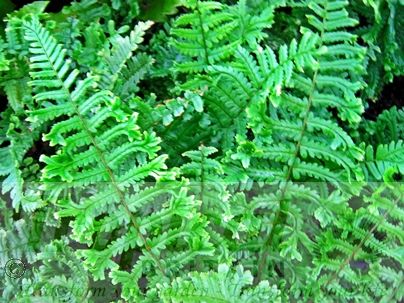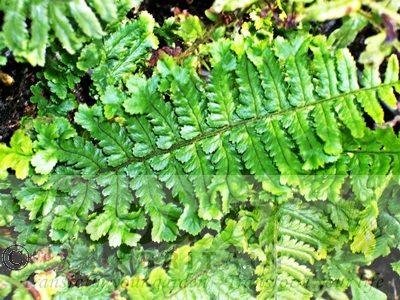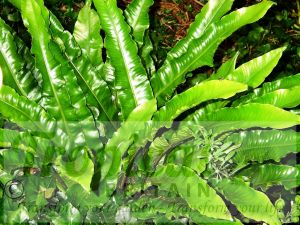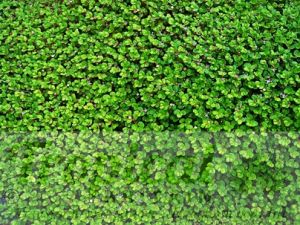Dryopteris pseudomas 'Cristata'
Dryopteris pseudomas 'Cristata' was originally found wild near St. Austell, Cornwall around 1850 during the Victorian Pteridomania when collecting wild ferns was all the rage. A rare naturally-occuring cristate form it has a line of cresting at the pinna-tips and frond-apex forming a fringe around the fronds and - most of the time - comes true to spore. It was also thought to have been found shortly afterwards near Ilfracombe in Devon, possibly by one of the two specialist Fern dealers and Nurserymen who operated there in what can be described as the epicentre of the Victorian Fern Cult. These two nurserymen were John Dadd who operated Dadd's North Devon Fernery and Rosary at Langleigh and John Lewis who owned The Fernery at Slade which was run by his son-in-law, Thomas Snell. Whether or not either of these two actually found a naturally occuring form or simply acquired one and propagated it for sale is not known.
In 1880, Captain (later Colonel) A. M. Jones, Treasurer of the British Pteridological Society wrote about it as "perhaps the grandest and most useful of British Ferns, and it is scarcely to the credit of Pteridologists that its history should still remain obscure; - all that is known is that it was found in the parish of St. Austell, in the grounds of Caercleugh and that the plant was at Kew in 1850". Indeed, this plant is still curiously obscure about its identity and is bedeviled by synonyms and taxonomical confusion. The type species was named by Wollaston as Lastreas pseudo-mas and the cristate form was described by Thomas Moore, Curator of the Society of Apothecaries Garden, in 1851 as Lastrea pseudo-mas cristata, just a year after its discovery. So far, so good, but as the years have rolled on, it has gathered a plethora of synonyms and common names.
It was Charles Druery who first called this fern the King of the Male Ferns and it has been been referred to as 'The King' or 'Cristata the King' ever since. Writing in Vol 1, No 1, of The British Fern Gazette, published by the British Pteridological Society, in September 1909, Druery gives us a fascinating description of the method by which he trains it into a tree fern. The article is worth quoting at length ...
"We have before us as we write a splendidly grown specimen of this truly regal British Fern, the fronds of which are fully four feet in length, while the trunk, which thirty years of proper culture has enabled it to develop, adds a full foot and a-half and constitutes it a thorough-bred British Tree Fern. This plant belongs to the hard evergreen section of the Male Ferns as distinct from the softer section "filix-mas," the common Male Fern, and therefore is as ornamental in the winter, when foliage is precious, as in the summer when it becomes one of a host among deciduous species. It is heavily and symmetrically tasselled at the tips of its fronds and pinnae, or side divisions. This imparts a highly ornate character to it, far and away eclipsing the simpler beauty of the normal form of the species...
... Thanks to the fertility above mentioned and the extremely easy culture of the Fern, no collection exists without one or more specimens, but this means little so far as adequate recognition is concerned, for it should not merely figure in collections; its hardiness, beauty and cheapness entitle it to a place in every rockery as well as to a high post of honour under glass. To attain the result, however, which we have described, viz. the aspect of a Tree Fern, there is just that touch of careful and persistent culture required, which makes a fern plant precious. If we have nothing to do but dump a plant into a pot and it straightway grows like a weed, producing offsets in all directions and becoming a bush, we are apt to think little of it, but if, on the other hand, we can, by checking its exuberance in certain directions, induce it to assume a specially beautiful character and then maintain it, we feel we have, as it were, a " finger in the pie," and that some of the credit is due to ourselves. This is precisely the case with the "King of the Male Ferns," that very gift of fertility in offsets above alluded to has to be persistently checked if we want a Tree Fern; if we obtain a crown of the plant and install it in a pot, in a short time it will send up a charming shuttlecock of its tasselled fronds and promise to be all right, but very soon we shall find little fronds peeping out at the base of the big ones and all round a little forest of youngsters will appear, each one developed from a bulbil near the base of the big fronds. These grow apace and in time we have a dense bush in which the original shuttlecock is indistinguishably merged, while the whole lot are fighting for existence in the limited area of soil which should only serve for one crown. Hence a mass of medium-sized fronds, pretty but mediocre. If, however, so soon as these little basal fronds become tangible plants we prize them off with a blunt knife, we shall find them come away with a little bunch of roots, all ready to give to admiring friends or pot up for additional specimens. These removed, more will come in time, but we must persist, and presently we shall see that the original shuttlecock, freed from competition at its roots or contributions from itself towards a brood of youngsters, is fattening up its crown tremendously as a preliminary to sending up a circle of great robust fronds with double the development of those in the bush. Each year this goes on until the maximum height is attained and a trunk begins to form by the annual crown always springing up within that of the previous year at a slightly higher level, while the old fronds, dropping in the late spring as they are pushed outwards by the new ones, leave their stumps as a contribution. All this time the youngsters will have been trying to assert themselves, but as time goes on the tendency decreases, and, finally, the old plant has obtained such a foothold that if any appear they are too far from the ground to become rivals, though they still should be removed.
The trunk of our specimen by no means represents a full-sized one, as we have seen very old plants with trunks fully two feet high, but at this stage, unless grown in a damp atmosphere and the trunk is frequently sprinkled, the size of the fronds is apt to dwindle. This is due to the fact that, like all trunk-forming or tree ferns, each year's growth sends down its independent bundles of root fibres from the bases of the new fronds, and these, naturally, if they have to travel far down a dry trunk, are apt to suffer on their way to the soil. The trunk is consequently strengthened year by year, and is gradually built up by these interlacing roots and the old bases of the decayed fronds...
... the subject of our remarks has many points of interest besides its intrinsic beauty to recommend it, and, to our mind, by no means the least of these is its longevity, since there are few pot plants which will last their owner's lifetime without depreciation, as will the ''King of the Male Ferns" when once properly established as a Tree Fern."
In a later edition of The British Fern Gazette, (Vol 2 No 13, September 1912), Druery returns to this theme and to a plant with which he was obsessed ...
"Amongst our native species we have none which, unassisted, will form a rising trunk, but with assistance, Lastrea pseudo-mas var. cristata, appropriately called the "King of the Male Ferns," will do so, and we have a specimen some thirty years old which has a well-developed trunk nearly 2 feet high. We have said that assistance is required, and that is of two kinds. First of all, the species has a habit of producing young plants from the frond bases, and these must be persistently removed as they appear, otherwise a bush of moderately sized plants is produced, but when removed the main plant, invigorated by non-competition with its assertive offspring, gradually rises, and in time loses this prolific habit. The second aid is afforded by watering the trunk as above indicated, to encourage the aerial root formation. The specimen we have in view as we write, though, of course, small as compared with Dicksonias, Cyatheas, and others of the Tree- fern tribe, is yet very handsome, having a trunk of the height described, surmounted with some fifteen or sixteen fronds between 4 feet and 5 feet long, and beautifully tasselled at all terminals."
Druery also discovered that this plant was aposporous. Apospory is the direct vegetative process which leads from the sporophyte to the gametophyte without the intervention of spores. He wrote ... "Apart from its beauty, hardiness, evergreen character and permanence as a pot plant, it is extremely interesting from the scientific side, since investigation has shown that its spores are peculiar in yielding fresh plants without any fertilization process, simple buds being produced on the prothallus, or little green scale, formed by the spore. It is probably due to this simplification that no fern is more easily raised from spores, and, indeed, it comes up freely as strays among sowings of other kinds and in the fernery generally."
Later this remarkable fern was reclassified as Dryopteris pseudomas 'Cristata' but it is usually sold today as Dropteris affinis 'Cristata' although Dropteris affinis is still taxonomically unresolved. Indeed many nurserymen just sell it simply as 'The King' or 'Cristata The King', perhaps unaware of its unique and colourful horticultural history and the origins of this name.
Additional Information
| Order | Polypodiales |
|---|---|
| Family | Dryopteridaceae |
| Synonyms | Dryopteris abbreviata, Dryopteris affinis 'Cristata', Dryopteris affinis 'Cristata The King', Dryopteris affinis subsp affinis var. affinis 'Cristata', Dryopteris affinis subsp affinis var. affinis 'Cristata The King', Dryopteris borreri, Dryopteris filix-mas var. abbreviata, Dryopteris filix-mas subsp. borreri, Dryopteris filix-mas var. borreri, Dryopteris mediterranea, Dryopteris pseudo-mas 'Cristata', Lastrea pseudomas cristata, Lastrea pseudo-mas var. cristata, Nephrodium pseudomas cristata, Polystichum abbreviatum |
| Geographical Origin | A naturally occuring cristate form from South-West England. The type species occurs throughout the UK, western and southern Europe and southwestern Asia |
| Cultivation | Shade. Moist atmosphere. Damp humus-rich soil. |
| Eventual Height | 1.5 m |
| Eventual Spread | 3 m |
| Hardiness | Fully hardy |

Free DELIVERY
ON ALL ORDERS OVER £99THIS OFFER IS VALID ON ALL OUR STORE ITEMS.













